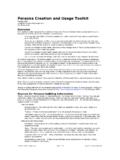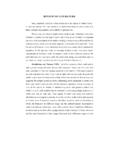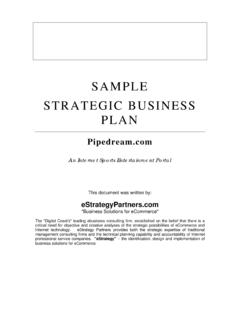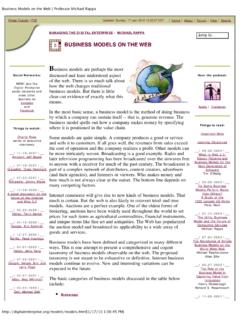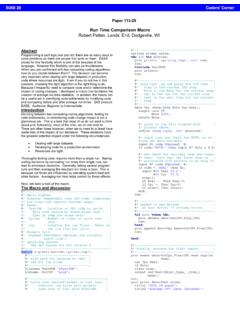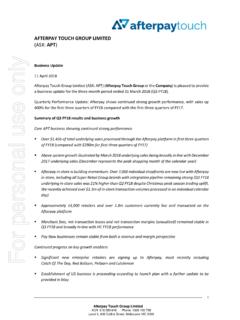Transcription of Customer Relationship Management in Banking …
1 Customer RelationshipManagement in Banking Sectorand A Model Design for BankingPerformance EnhancementSemih OnutIbrahim ErdemYildiz Technical UniversityDept. Of Industrial EngineeringYildiz, 80750, HosverGaranti BankCustomer Relationship & Marketing :63, Maslak, IntroductionToday, many businesses such as banks, insurance companies, and other serviceproviders realize the importance of Customer Relationship Management (CRM) andits potential to help them acquire new customers, retain existing ones and maximizetheir lifetime value. At this point, close Relationship with customers will require astrong coordination between IT and marketing departments to provide a long-termretention of selected customers.
2 This paper deals with the role of CustomerRelationship Management in Banking sector and the need for Customer RelationshipManagement to increase Customer value by using some analitycal methods in is a sound business strategy to identify the bank s most profitable customersand prospects, and devotes time and attention to expanding account relationships withthose customers through individualized marketing, repricing, discretionary decisionmaking, and customized service-all delivered through the various sales channels thatthe bank uses. Under this case study, a campaign Management in a bank is conductedusing data mining tasks such as dependency analysis, cluster profile analysis, conceptdescription, deviation detection, and data visualization.
3 Crucial business decisionswith this campaign are made by extracting valid, previously unknown and ultimatelycomprehensible and actionable knowledge from large databases. The modeldeveloped here answers what the different Customer segments are, who more likely torespond to a given offer is, which customers are the bank likely to lose, who mostlikely to default on credit cards is, what the risk associated with this loan applicant , a cluster profile analysis is used for revealing the distinct characteristics ofeach cluster, and for modeling product propensity, which should be implemented inorder to increase the Customer Relationship ManagementIn literature, many definitions were given to describe CRM.
4 The main differenceamong these definitions is technological and Relationship aspects of CRM. Someauthors from marketing background emphasize technological side of CRM while theothers considers IT perspective of CRM. From marketing aspect, CRM is defined by[Couldwell 1998] as .. a combination of business process and technology that seeksto understand a company s customers from the perspective of who they are, what theydo, and what they are like . Technological definition of CRM was given as .. themarket place of the future is undergoing a technology-driven metamorphosis [Peppers and Rogers 1995]. Consequently, IT and marketing departments must workclosely to implement CRM efficiently.
5 Meanwhile, implementation of CRM inbanking sector was considered by [Mihelis et al. 2001]. They focused on theevaluation of the critical satisfaction dimensions and the determination of customergroups with distinctive preferences and expectations in the private bank sector. Themethodological approach is based on the principles of multi-criteria modeling andpreference disaggregation modeling used for data analysis and interpretation. [Yli-Renko et al. 2001] have focused on the Management of the exchange relationshipsand the implications of such Management for the performance and development oftechnology-based firms and their customers. Spesifically the Customer relationships ofnew technology-based firms has been studied.
6 [Cook and Hababou, 2001] wasinterested in total sales activities, both volume-related and non-volume related. Theyalso developed a modification of the standard data envelope analysis (DEA) structureusing goal programming concepts that yields both a sales and service measures.[Beckett-Camarata et al. 1998] have noted that managing relationships with theircustomers (especially with employees, channel partners and strategic alliancepartners) was critical to the firm s long-term success. It was also emphasized thatcustomer Relationship Management based on social exchange and equity significantlyassists the firm in developing collaborative, cooperative and profitable long-termrelationships.
7 [Yuan and Chang 2001] have presented a mixed-initiative synthesizedlearning approach for better understanding of customers and the provision of clues forimproving Customer relationships based on different sources of web Customer have also hierarchically segmented data sources into clusters, automaticallylabeled the features of the clusters, discovered the characteristics of normal, defectedand possibly defected clusters of customers, and provided clues for gaining customerretention. [Peppers 2000] has also presented a framework, which is based onincorporating e-business activities, channel Management , Relationship managementand back-office/front-office integration within a Customer centric strategy.
8 He hasdeveloped four concepts, namely Enterprise, Channel Management , Relationships andManagement of the total enterprise, in the context of a CRM initiative. [Ryals andKnox 2001] have identified the three main issues that can enable the development ofCustomer Relationship Management in the service sector; the organizational issues ofculture and communication, Management metrics and cross-functional integration-especially between marketing and information CRM Objectives in Banking SectorThe idea of CRM is that it helps businesses use technology and human resources gaininsight into the behavior of customers and the value of those customers. If it works ashoped, a business can: provide better Customer service, make call centers moreefficient, cross sell products more effectively, help sales staff close deals faster,simplify marketing and sales processes, discover new customers, and increasecustomer doesn't happen by simply buying software and installing it.
9 ForCRM to be truly effective, an organization must first decide what kind of customerinformation it is looking for and it must decide what it intends to do with thatinformation. For example, many financial institutions keep track of customers' lifestages in order to market appropriate Banking products like mortgages or IRAs tothem at the right time to fit their needs. Next, the organization must look into all ofthe different ways information about customers comes into a business, where and howthis data is stored and how it is currently used. One company, for instance, mayinteract with customers in a myriad of different ways including mail campaigns, Websites, brick-and-mortar stores, call centers, mobile sales force staff and marketing andadvertising efforts.
10 Solid CRM systems link up each of these points. This collecteddata flows between operational systems (like sales and inventory systems) andanalytical systems that can help sort through these records for patterns. Companyanalysts can then comb through the data to obtain a holistic view of each customerand pinpoint areas where better services are needed. In CRM projects, following datashould be collected to run process engine: 1) Responses to campaigns, 2) Shippingand fulfillment dates, 3)Sales and purchase data, 4) Account information, 5) Webregistration data, 6) Service and support records, 7) Demographic data, 8) Web A Model Design for CRM At Garanti BankGaranti Bank, one of the leading banks in Turkey were looking at new ways toenhance its Customer potential and service quality.
